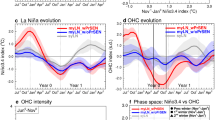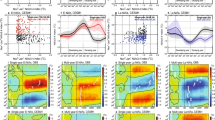Abstract
Compared with well documented and frequent occurrence of multi-year La Niña, double-year El Niño is less frequent and has not been well investigated. Both of them are a discrepancy from the cyclic behavior of the El Niño-Southern Oscillation and deserve investigation. Here, we demonstrate the diversity of single- and double-year El Niño events in their strengths, flavors, as well as associations with the recharge/discharge processes. The possible different climate impacts are also discussed. During 1950–2021, 75% of El Niño events persist for one year, and 25% of them last for two years. Both central and eastern Pacific type El Niños occur in the single-year and double-year El Niños with various strengths. On average, there is no relationship between the initial time and duration of an El Niño event. Compared with the single-year El Niños, the averaged warm water volume (WWV) is larger in the peak and declines slower for the double-year El Niños, suggesting that a persistently recharged heat condition of the equatorial Pacific is a precondition for the emergence of a second-year El Niño. The faster decline of WWV in the single-year El Niños is associated with the in-phase decrease of its intraseasonal-interseasonal and interannual components, while the slower decline of WWV in the double-year El Niños is determined by the interannual component. In addition, the single-year and double-year El Niño may have different impacts on regional climate.







Similar content being viewed by others
Data Availability
The analysis and reanalysis data used in this work are available through Kalnay et al. (1996), Chen et al. (2002), Rayner et al. (2003), Balmaseda et al. (2013), Behringer (2007), Li et al. (2022b), and also online: NCEP/NCAR reanalysis from https://psl.noaa.gov/data/gridded/data.ncep.reanalysis.html, precipitation from https://psl.noaa.gov/data/gridded/data.precl.html, HadISST from http://hadobs.metoffice.com/hadisst/data/download.html, ORAs4 D20 from https://climatedataguide.ucar.edu/climate-data/oras4-ecmwf-ocean-reanalysis-and-derived-ocean-heat-content, and GODAS D20 from https://www.esrl.noaa.gov/psd/data/gridded/data.godas.html, respectively, or contact us via ztgtq@sina.com.
References
An S-I, Kim J-W (2018) ENSO transition asymmetry: Internal and external causes and Intermodel diversity. Geophys Res Lett 45:5095–5104. doi: https://doi.org/10.1029/2018GL078476
Balmaseda MA, Mogensen K, Weaver AT (2013) Evaluation of the ECMWF ocean reanalysis system ORAS4. Q J R Meteorol Soc 139:1132–1161. doi: https://doi.org/10.1002/qj.2063
Barnston AG, Tippett MK, L’Heureux ML, Li S, DeWitt DG (2012) Skill of real-time seasonal ENSO model predictions during 2002–2011 — Is our capability increasing? Bull Amer Meteor Soc 93(5):631–651. doi: https://doi.org/10.1175/BAMS-D-11-00111.1
Behringer DW (2007) : The Global Ocean Data Assimilation System (GODAS) at NCEP. Preprints, 11th Symp. on Integrated Observing and Assimilation Systems for Atmosphere, Oceans, and Land Surface, San Antonio, TX, Amer. Meteor. Soc., 3.3. [Available online at http://ams.confex.com/ams/87ANNUAL/techprogram/paper_119541.htm]
Bjerknes, J., 1969: Atmospheric teleconnections from the equatorial Pacific. Mon. Wea. Rev., 97, 163– 172, doi: 10.1175/1520-0493(1969)0972.3.CO;2.
Chen M, Xie P, Janowiak JE, Arkin PA (2002) Global land precipitation: A 50-yr monthly analysis based on gauge observations. J Hydrometeor 3:249–266
Choi K, Vecchi GA, Wittenberg AT (2013) ENSO transition, duration, and amplitude asymmetries: Role of the nonlinear wind stress coupling in a conceptual model. J Clim 26(23):9462–9476
Ding R, Tseng Y-h, Di Lorenzo E, Shi L, Li J, Yu J-Y, Wang C, Sun C, Luo J-J, Ha K-J, Hu Z-Z, Li F (2022) : Multi-year El Niño events tied to the North Pacific Oscillation. Nature-Communications 13, 3871. DOI: https://doi.org/10.1038/s41467-022-31516-9
Hoerling M, Kumar A, Zhong M (1997) El Niño, La Niña, and the nonlinearity of their teleconnections. J Clim 10:1769–1786
Hu Z-Z, Kumar A, Xue Y, Jha B (2014) Why were some La Niñas followed by another La Niña? Clim Dyn 42(3–4):1029–1042. doi: https://doi.org/10.1007/s00382-013-1917-3
Hu Z-Z, Kumar A, Huang B, Zhu J, Zhang R-H, Jin F-F (2017) Asymmetric evolution of El Niño and La Niña: The recharge/discharge processes and role of the off-equatorial sea surface height anomaly. Clim Dyn 49(7–8):2737–2748. doi: https://doi.org/10.1007/s00382-016-3498-4
Hu Z-Z, Kumar A, Jha B, Huang B (2020a) How much of monthly mean precipitation variability over global land is associated with SST anomalies? Clim Dyn 54(1–2):701–712. doi: https://doi.org/10.1007/s00382-019-05023-5
Hu Z-Z, Kumar A, Huang B, Zhu J, L’Heureux M, McPhaden MJ, Yu J-Y (2020b) The interdecadal shift of ENSO properties in 1999/2000: A review. J Clim 33(11):4441–4462. doi: https://doi.org/10.1175/JCLI-D-19-0316.1
Huang B, Thorne PW, Banzon VF, Boyer T, Chepurin G, Lawrimore JH, Menne MJ, Smith TM, Vose RS, Zhang H-M (2017) Extended Reconstructed Sea Surface Temperature version 5 (ERSSTv5), Upgrades, validations, and intercomparisons. J Clim 30(20):8179–8205. doi: https://doi.org/10.1175/JCLI-D-16-0836.1
Jin, F.-F., 1997: An equatorial ocean recharge paradigm for ENSO. Part I: Conceptual model. J. Atmos. Sci., 54, 811–829, doi: https://doi.org/10.1175/1520-0469(1997)0542.0.CO;2.
Kalnay E, Kanamitsu M, Kistler R, Collins W, Deaven D, Gandin L, Iredell M, Saha S, White G, Woollen J, Zhu Y, Chelliah M, Ebisuzaki W, Higgins W, Janowiak J, Mo KC, Ropelewski C, Wang J, Leetmaa A, Reynolds R, Jenne R, Joseph D (1996) The NCEP/NCAR 40-year reanalysis project. Bull Amer Meteor Soc 77:437–471
Kao H-Y, Yu J-Y (2009) Contrasting eastern-Pacific and central-Pacific types of ENSO. J Clim 22:615–632. doi: https://doi.org/10.1175/2008JCLI2309.1
Kessler WS (2002) Is ENSO a cycle or a series of events? Geophys Res Lett 29(23):2125. doi: https://doi.org/10.1029/2002GL015924
Kim J-W, Yu J-Y (2021) Evolution of subtropical Pacific-onset El Niño: How its onset location controls its decay evolution. J Geophys Res 48 e2020GL091345. doi: https://doi.org/10.1029/2020GL091345
Kim J-W, Yu J-Y (2022) Understanding reintensified multiyear El Niño events. Geophys Res Lett 47. doi: https://doi.org/10.1029/2020GL087644
Li X, Hu Z-Z, Huang B (2019) Contributions of atmosphere-ocean interaction and low-frequency variation to intensity of strong El Niño events since 1979. J Clim 32(5):1381–1394. doi: https://doi.org/10.1175/JCLI-D-18-0209.1
Li X, Hu Z-Z, Zhao S, Ding R, Zhang B (2022a) : The asymmetry of the tropical Pacific thermocline fluctuation associated with ENSO recharge and discharge. Geophys. Res. Lett., 49 (11), e2022GL099242, doi: https://doi.org/10.1029/2022GL099242
Li X, Hu Z-Z, Tseng Y-h, Liu Y, Liang P: 2022b: A Historical Perspective of the La Niña Event in 2020/21.J. Geophys. Res., 127 (7), e2021JD035546, doi: https://doi.org/10.1029/2021JD035546
McPhaden MJ, Santoso A, Cai W (2021) : El Niño Southern Oscillation in a Changing Climate. Geophysical Monograph 253, American Geophysical Union, Wiley, 1-506, doi: https://doi.org/10.1002/9781119548164
Meinen CS, McPhaden MJ (2000) Observations of warm water volume changes in the equatorial Pacific and their relationship to El Niño and La Niña. J Clim 13:3551–3559. doi: https://doi.org/10.1175/1520-0442
National Research Council (2010) : Assessment of Intraseasonal to Interannual Climate Prediction and Predictability, 192 PP., ISBN-10: 0-309-15183-X, the National Academies Press, Washington, D. C., USA
Ohba M, Ueda H (2009) Role of nonlinear atmospheric response to SST on the asymmetric transition process of ENSO. J Clim 22:177–192
Okumura YM, Deser C (2010) Asymmetry in the duration of El Niño and La Niña. J Clim 23:5826–5843
Okumura YM, Ohba M, Deser C, Ueda H (2011) A proposed mechanism for the asymmetric duration of El Niño and La Niña. J Clim 24:3822–3829. doi: https://doi.org/10.1175/2011JCLI3999.1
Rayner NA, Parker DE, Horton EB, Folland CK, Alexander LV, Rowell DP, Kent EC, Kaplan A (2003) Global analyses of sea surface temperature, sea ice, and night marine air temperature since the late nineteenth century. J Geophys Res 108(D14):4407. doi: https://doi.org/10.1029/2002JD002670
Timmermann A et al (2018) El Niño–Southern Oscillation complexity. Nature 559(7715):535–545. doi: https://doi.org/10.1038/s41586-018-0252-6
van Oldenborgh GJ, Hendon H, Stockdale T, L’Heureux M, de Perez EC, Singh R, van Aalst M (2021) Defining El Niño indices in a warming climate. Environ Res Lett 16(4):044003. doi: https://doi.org/10.1088/1748-9326/abe9ed
Wang, C., 2001: A unified oscillator model for the El Niño-Southern Oscillation. J. Climate, 14, 98-115.
Wu, R., Z.-Z. Hu, and B. P. Kirtman, 2003: Evolution of ENSO-related rainfall anomalies in East Asia. J. Climate, 16 (22), 3742-3758, doi: https://doi.org/10.1175/1520-0442(2003)0162.0.CO;2.
Wu X, Okumura YM, DiNezio PN (2019) What controls the duration of El Niño and La Niña events? J Clim 32:5941–5965. doi: https://doi.org/10.1175/JCLI-D-18-0681.1
Wu Z, Huang NE (2009) Ensemble Empirical Mode Decomposition: a noise- assisted data analysis method. Adv Adapt Data Anal 1:1–41. doi: https://doi.org/10.1142/S1793536909000047
Yeo SR, Yeh SW, Kim KY, Kim WM (2016) The role of low frequency variation in the manifestation of warming trend and ENSO amplitude. Clim Dyn 49(4):1197–1213. doi: https://doi.org/10.1007/s00382-016-3376-0
Zhu J, Kumar A, Huang B, Balmaseda MA, Hu Z-Z, Marx L, Kinter JL III (2016) The role of off-equatorial surface temperature anomalies in the 2014 El Niño prediction. Sci Rep 6:19677. doi: https://doi.org/10.1038/srep19677
Acknowledgements
The authors appreciate the constructive comments and insightful suggestions from reviewers, which help us to improve this work significantly. The authors declare no financial conflict of interest. This work was supported by the National Natural Science Foundation of China (41630424, 41875119, 41930967, and 41661144007).
Author information
Authors and Affiliations
Corresponding author
Additional information
Publisher’s Note
Springer Nature remains neutral with regard to jurisdictional claims in published maps and institutional affiliations.
Rights and permissions
Springer Nature or its licensor holds exclusive rights to this article under a publishing agreement with the author(s) or other rightsholder(s); author self-archiving of the accepted manuscript version of this article is solely governed by the terms of such publishing agreement and applicable law.
About this article
Cite this article
Gao, Z., Hu, ZZ., Zheng, F. et al. Single-year and double-year El Niños. Clim Dyn 60, 2235–2243 (2023). https://doi.org/10.1007/s00382-022-06425-8
Received:
Accepted:
Published:
Issue Date:
DOI: https://doi.org/10.1007/s00382-022-06425-8




